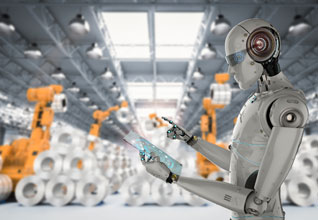

July 10 2019

When narrowing down your specifications for a new web handling or converting system, it is important to consider the various levels of automation that are available, the costs associated with each, and the long-term savings that are realized by including these features in your initial purchase.
Machine automation exists in a variety of forms, each of which are intended to provide improvements to your manufacturing process. Automation can reduce machine setup times, can prevent operator exposure to unsafe conditions, can improve process accuracy, can allow higher operating speeds, and can reduce operating costs. Additionally, automated process monitoring can be used to predict component failure or identify machine maladjustment, both of which can reduce waste, rework, or unplanned downtime. These are all positives to be considered, but they come with a cost that must be weighed against the alternatives of operating without these features.
Short runs and frequent changeovers can benefit from having machine set points and adjustments made automatically by the control system while the operator tends to other tasks. This form of automation can improve the accuracy and repeatability of your manufacturing process by eliminating the potential variability from operator to operator. By their very nature, short runs can mean low machine uptime. So, any advantage that automation can offer to reduce the downtime between runs can improve your bottom line and reduce the return on investment.
When production requirements call for higher operating speeds and larger finished roll sizes, demands are placed on operators to handle heavier loads at a faster pace. Many options exist to automate material handling tasks to meet these demands and increase machine throughput, but more importantly help to prevent operator injuries. Tasks associated with producing roll goods from a continuous process can no longer be safely accomplished manually by an operator as line speeds increase. Starting new rolls and unloading finished rolls automatically are necessary machine features to keep up with higher production speeds. The added productivity that these features provide can quickly offset the added investment costs.
Adding automation to make your manufacturing process more accurate, more productive, faster, and less labor-intensive seems to make a lot of intuitive sense. In many cases it does, but it needs to make practical sense for your application. Additionally, it also needs to be compatible with ongoing operating preferences and future requirements to realistically justify over time the added costs associated with the extra capabilities. These costs not only include the specific equipment and controls associated with automating the system but also typically the costs in achieving and maintaining overall process and product parameters so that winding and slitting automation performs as intended. In this regard, automation is not a catch-all solution to accommodate aspects outside its specific control range. For example, in many cases significant additional costs can result from the need for tighter tolerance materials (including cores) and consistent use of best practices to ensure reliable hands-off feeding, positioning and processing, and quite possibly the added cost of a more technically adept maintenance staff to keep things running smoothly. Many times, these and other costs outside of the system being automated are not considered.
Automation can be an effective tool for improving productivity, safety and profitability. However, a careful analysis of all the costs necessary for automation to do its job, how quickly these costs can be paid for under realistic conditions and whether automated features can accommodate overall process and personnel variabilities now and in the future is essential in determining how much automation is practical for your operation. Take the time to understand the overall complexities, shortfalls and potential risks of automation within and outside the specific application. Start with conservative expectations regarding automation’s capabilities and your project objectives will more likely be achieved.